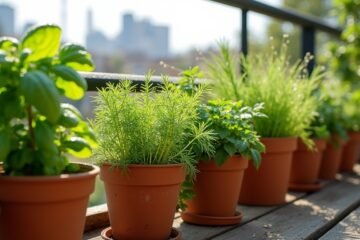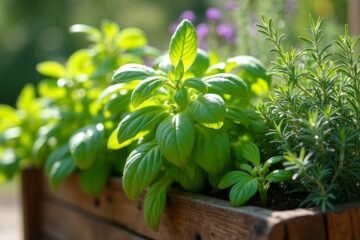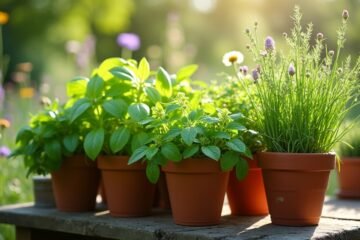To create a thriving container herb garden, start with charming pots that suit your style, like clay for rustic vibes or sleek ceramic for modern flair! Use rich, well-draining soil—think of it as the cozy bed for your herbs! Choose flavor buddies, like pairing basil with tomatoes. Don’t forget to keep an eye out for those pesky pests and trim regularly to keep things fresh! Ready for tips to make your herbs sing? You’re in for a treat!
Choose the Right Containers
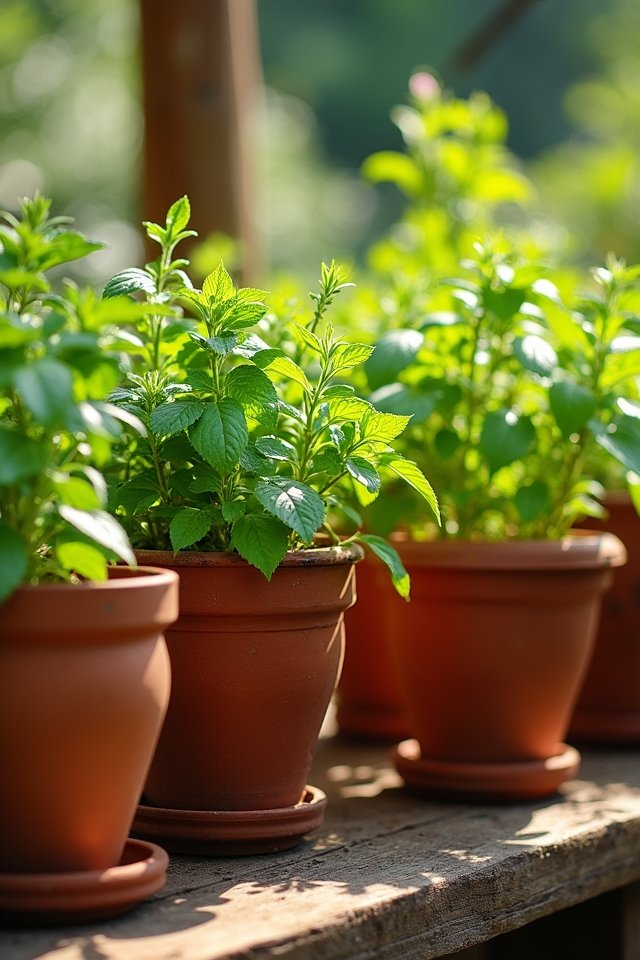
When it comes to choosing the right containers for your herb garden, think of it like picking the perfect outfit for a fancy dinner—comfort and style matter! You’ll want to reflect on container materials that not only reflect your personality but also promote your herbs’ growth. Clay pots offer a rustic charm, while sleek ceramic brings modern flair.
Then, there’s container sizes—don’t get stuck in the “one-size-fits-all” mentality! Bigger isn’t always better; for delicate basil, a petite pot works wonders. But for robust rosemary, go large! Balancing these aspects creates a stunning visual garden that’s both functional and trendy. So, channel your inner designer and let your herbs shine in their stunning new homes! Isn’t that exciting?
Select the Best Soil Mix
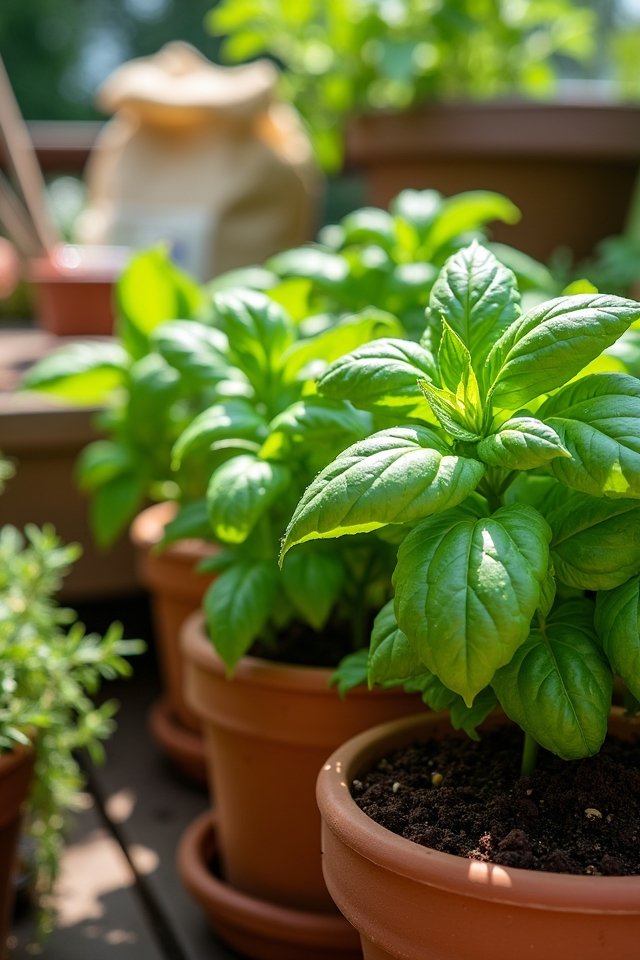
While you might think any old dirt will do, selecting the best soil mix for your herb garden is essential! A fantastically rich soil composition will give your herbs the zest they crave. Look for a blend that includes peat, perlite, and compost—these ingredients create that perfect harmony of nutrients and aeration! Don’t underestimate pH levels, either! Herbs prefer a slightly acidic to neutral pH, around 6.0 to 7.0. Too high or too low, and you might end up with a sad basil plant, wilted and weary. Remember, great herbs start with great soil, just like a fine chef begins with the best ingredients! So go ahead, mix it up and watch your herb garden thrive! Let’s get growing!
Ensure Proper Drainage
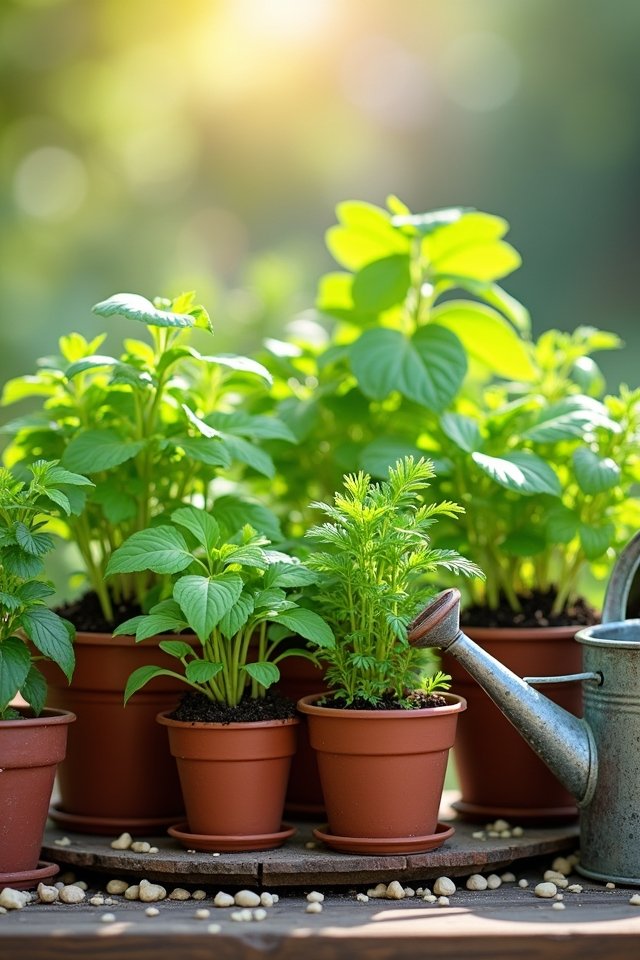
Great soil sets the stage for a thriving herb garden, but if your pots don’t have proper drainage, all that hard work can go right down the drain—literally! You want those herbs to flourish, not drown.
Here are some simple ways to guarantee effective drainage:
- Choose pots with drainage holes—your herbs need to breathe!
- Use self-watering containers for moisture retention, giving you a helping hand!
- Layer your potting mix—start with gravel at the bottom for quick drainage.
- Check regularly for blockage—don’t let roots get cozy in stale water!
With proper drainage, you’ll keep your herbs happy and healthy, dancing in their pots like they’re at a summer festival! Isn’t that the kind of garden you want?
Select Suitable Herb Varieties
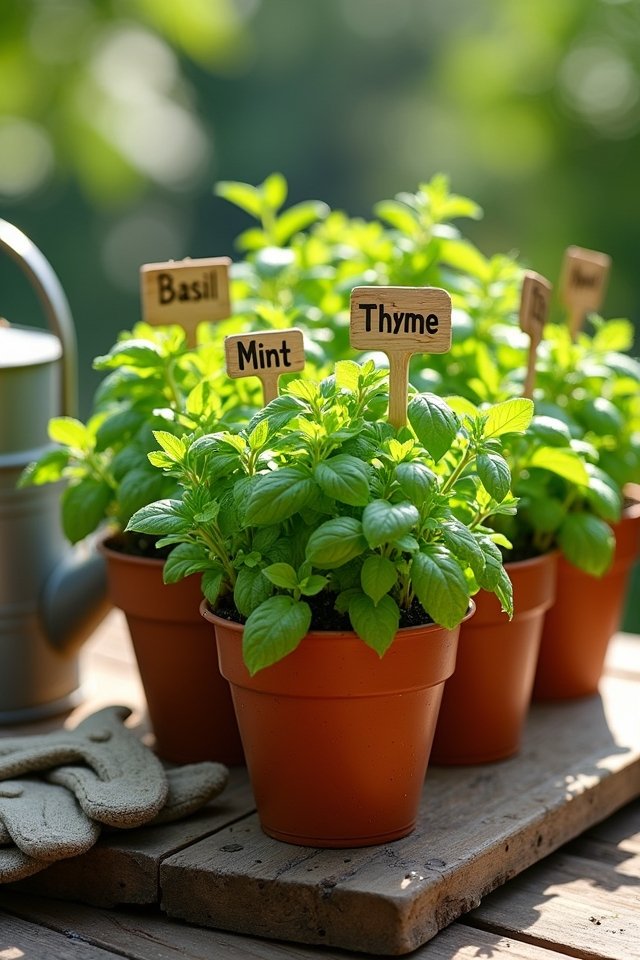
Selecting the right herb varieties can make or break your container garden, especially if you want a flavorful feast right at your fingertips! Imagine plucking fresh basil, its aroma bursting like confetti in the air, while adding vibrant parsley for a splash of green. Consider herb flavor profiles—some herbs complement others like pizza and cheese! Basil and tomatoes are a dynamic duo, perfect for companion planting. You might also try mint and rosemary; they don’t just taste great together, they thrive side-by-side! Don’t shy away from mixing robust flavors with delicate ones—why not give sweet marjoram a chance against zesty cilantro? Get creative, and watch your container garden flourish into a culinary wonderland!
Position Containers Wisely
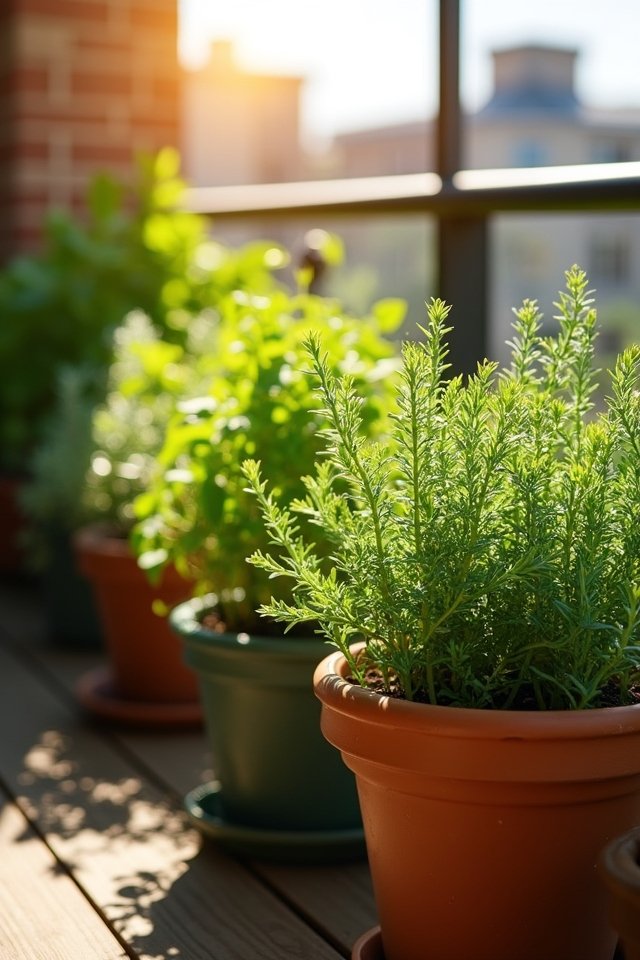
To make the most of your container herb garden, positioning those beauties is key! You want your herbs to reach for the sky, thriving under the sun while being shielded from gusty winds.
Consider these innovative tips:
- Give ’em the Sun: Place containers in spots with at least 6-8 hours of sunlight exposure daily.
- Wind Shielding: Position your pots near walls or fences to protect them from harsh winds.
- Rotate Regularly: Move those containers a bit every week for even sunlight exposure.
- Group Wisely: Cluster herbs with similar light and water needs together for ideal growth!
You’ll feel like a gardening wizard as your herbs flourish, ready to spice up your culinary creations!
Water Correctly
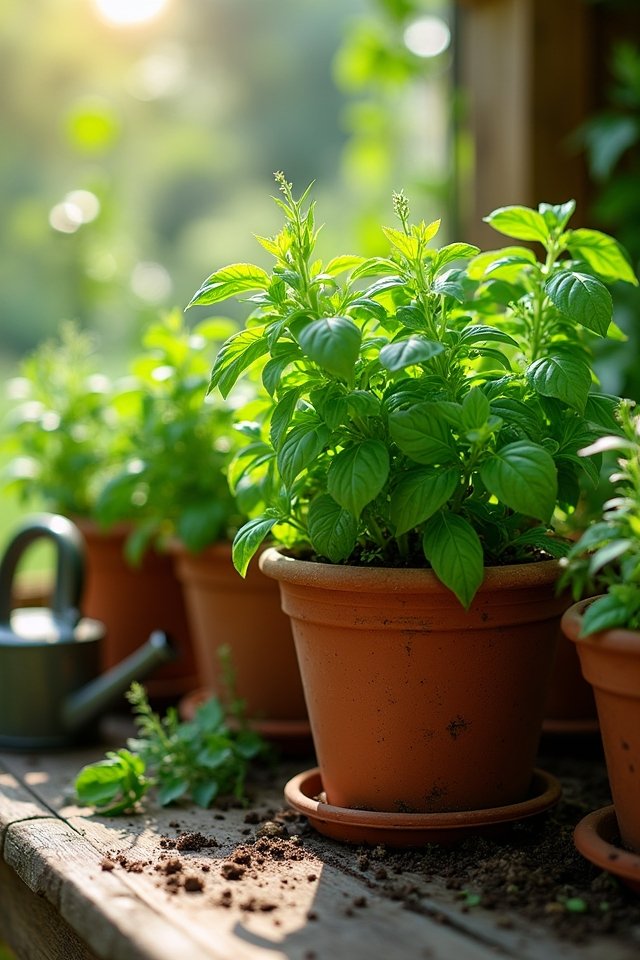
While you might think watering herbs is just a simple task, getting it right can feel like mastering a fine art! Imagine your herbs as thirsty little friends—too much water can drown them, while too little can leave them parched! Employ innovative watering techniques, like bottom watering, where you let the pot sit in a puddle and sip the moisture it craves. Check moisture levels by sticking a finger into the soil; if it feels dry an inch down, time for a drink! Sprinkling water gently instead of pouring can keep your herbs happy without washing away precious nutrients. So, tune into your herbs’ needs, and watch them thrive with every drop! Isn’t nurturing nature just exhilarating?
Prune and Harvest Regularly
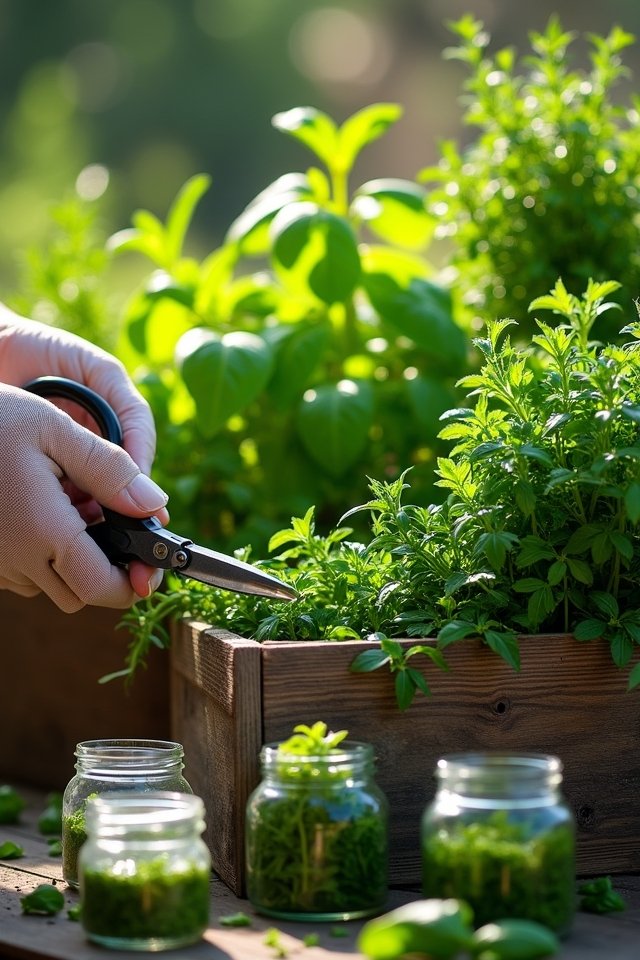
Snip away those leaves with joy—you’re about to commence on a flavor adventure! Regular pruning and harvesting not only encourages growth but also enhances the taste of your herbs. Try these innovative techniques to keep your garden thriving:
- Use sharp scissors or garden snips for clean cuts.
- Harvest in the morning when oils are most potent.
- Pinch back leaves to promote bushier plants.
- Rotate herb varieties to keep your palate excited!
Fertilize Appropriately
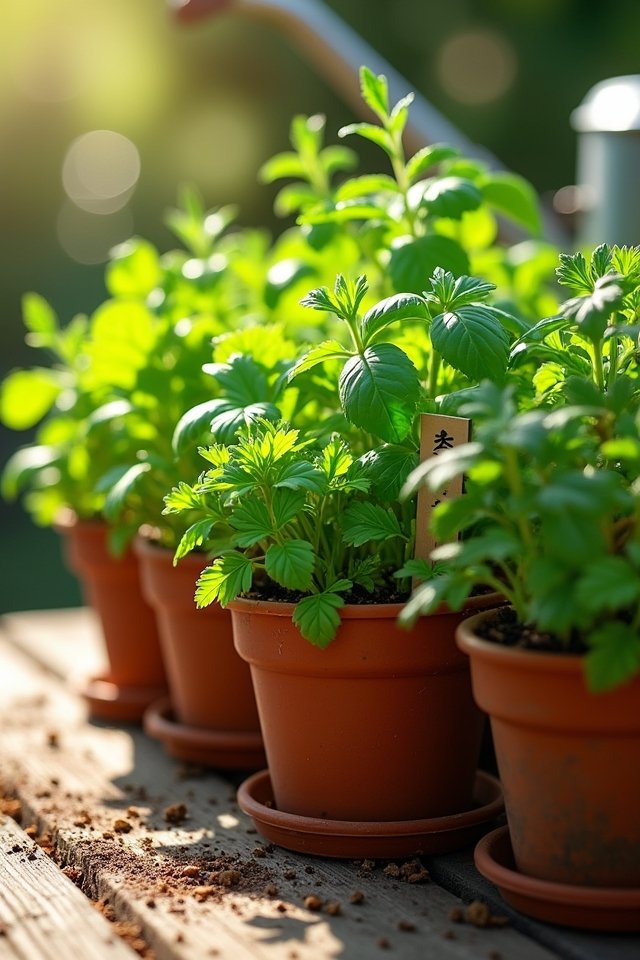
When your herbs are dancing in the sunlight, they’re ready for a little extra love in the form of fertilizer! Think of organic fertilizers as a delightful spa day for your green friends. You can’t go wrong with liquid nutrients; they’re like a invigorating smoothie packed with all the goodies. Just imagine your basil thriving, soaking up those rich minerals while your rosemary stands tall and proud!
Try feeding your herbs every two to four weeks in the growing season. Use a mix tailored for herbs; it’s a game changer! Don’t forget to dilute liquid nutrients; they’re potent! Water them in, and watch your little garden burst into life, encouraging vibrant flavors that’ll elevate your culinary creations. Happy gardening!
Monitor for Pests and Diseases
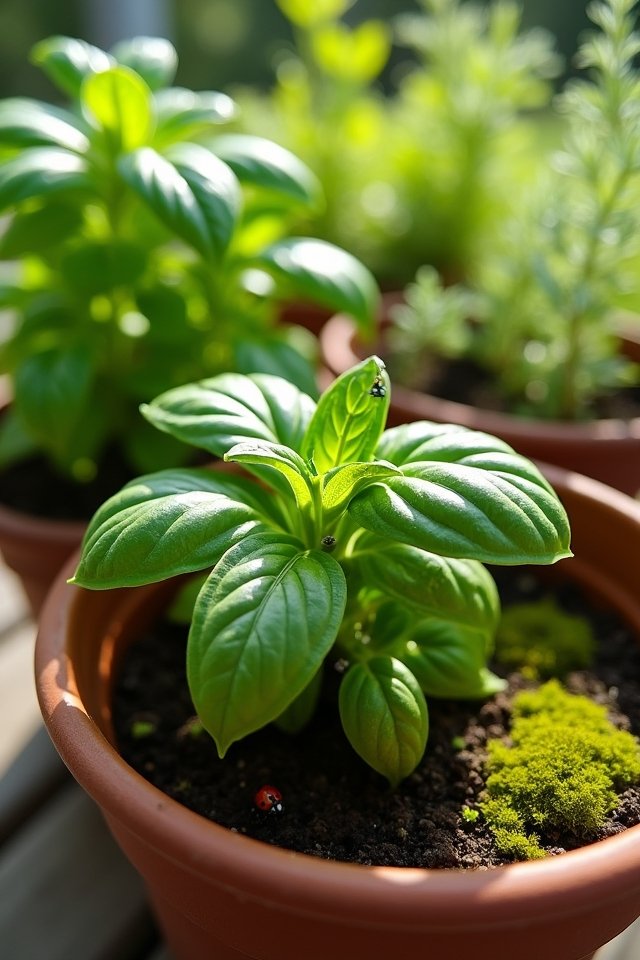
You can’t overlook the little critters and sneaky diseases that might want to crash your herb party! A vibrant herb garden can quickly turn dull when pests invade. Stay sharp on pest identification to guarantee your herbs thrive.
- Inspect your plants regularly for tiny intruders like aphids or spider mites.
- Look for unusual leaf spots that scream “disease alert!”
- Keep your garden tidy, as clean herbs are happier herbs!
- Use natural repellents, like neem oil, to fend off unwanted guests.
Act quickly! Disease prevention and pest identification are your best friends here. With a watchful eye and a few proactive measures, you can keep your garden glowing and pest-free. Ready to protect your herb haven? Let’s get to it!
Frequently Asked Questions
Can I Use Recycled Containers for My Herb Garden?
Absolutely, you can use recycled containers for your herb garden! Think of it as giving new life to what’s been deemed “waste”—like turning an old coffee can into a chic herb pot. Just guarantee it has proper drainage holes; soggy roots are no friend to your herbs! Experimenting with quirky containers, like mason jars or tin cans, can spark creativity. Plus, it’s a cute way to contribute to a greener planet! Who knew gardening could be so fun?
Are There Specific Herbs That Grow Well Indoors?
You’ll love growing indoor herb varieties like basil and mint. They thrive with just bright, indirect lighting and don’t need to soak in sunshine like sunbathers! Rosemary and chives also adore cozy indoor nooks, as long as you remember to water them. Imagine snipping fresh basil for your pasta—heavenly! Just think, your kitchen could smell like an Italian bistro! Ready to bring the garden inside? Let’s get growing!
How Often Should I Rotate My Herb Containers?
You should rotate your herb containers every couple of weeks for ideal sunlight exposure! Think of it as giving your herbs a little workout—changing their view keeps them lively and growing strong. Just like you’d want to chase the sun on a gorgeous day, your herbs need that radiant light as well! Try moving them to a sunnier spot or turning them around. Your mint and basil will thank you with vibrant leaves!
What Are Companion Plants for My Container Herbs?
Did you know that planting herbs together can boost growth by up to 25%? You’ll love pairing basil with tomatoes for an aromatic combo or mint with parsley for a fresh twist! These herb pairings not only taste amazing but also help with pest control, keeping those pesky bugs at bay. Imagine the flavor explosion in your dishes! So, get creative and mix those containers; your culinary masterpieces will thank you!
Can I Freeze My Harvested Herbs for Later Use?
Absolutely, you can freeze your harvested herbs for later use! It’s like capturing summer in a cube! Try chopping your herbs, placing them in ice cube trays, and covering them with olive oil or water. Once frozen, pop those fragrant cubes into bags for easy access! Talk about herb preservation innovation! Just imagine pulling out a flavorful burst of basil in winter—it’s like a taste of sunshine on your plate! How’s that for freshness?
